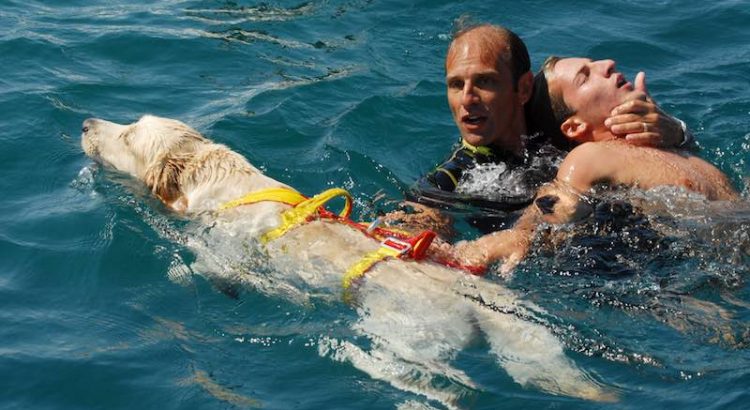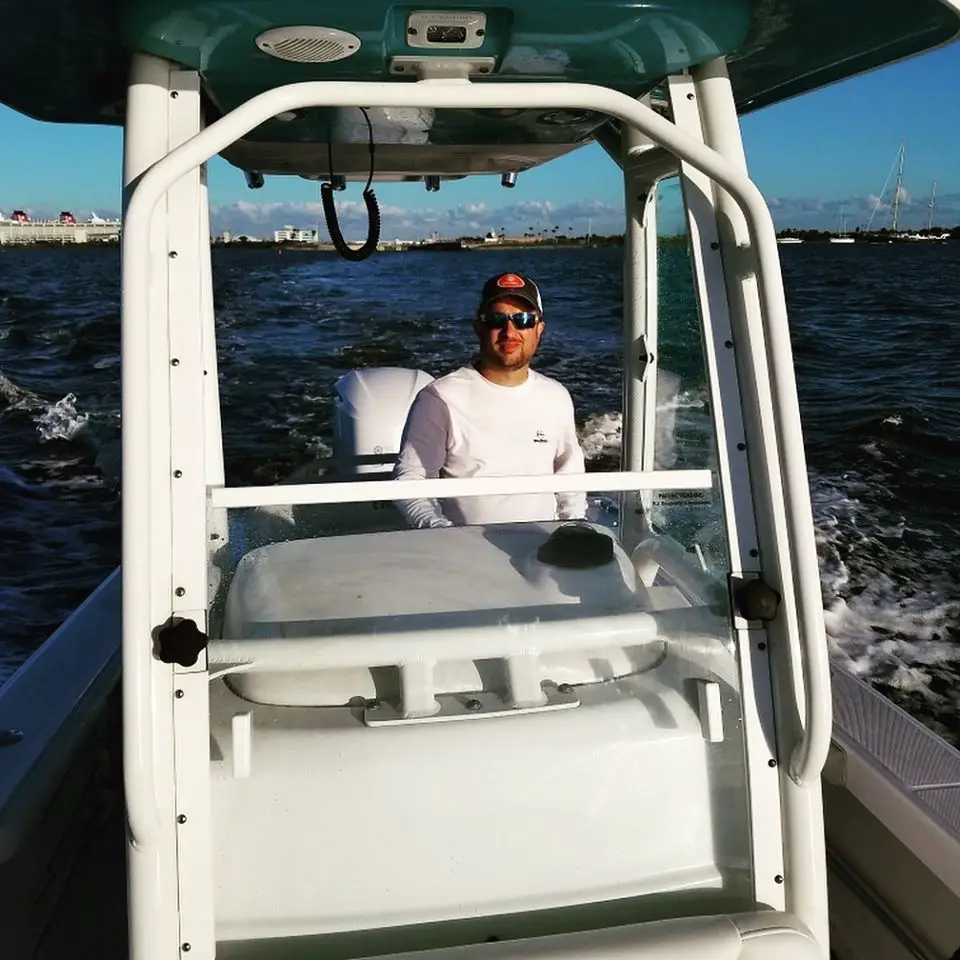This page contains affiliate links. This means that we may get a small commission for recommending products, if you choose to click on something and buy it. This does not cost you anything, but we wanted to be honest and let you know!
(Last Updated On: )The truth I do not stretch or shove
When I state that the dog is full of love.
I’ve also found, by actual test,
A wet dog is the lovingest.
The Dog – Ogden Nash
Table of Contents
Is My Dog a Candidate for Water Rescue?
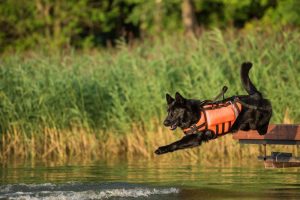
You have a beloved pooch who is energetic, smart, and eager to please. All of that energy needs an outlet, and the dog needs some type of “employment” to reach his full potential.
You have done some training, but wonder if there is more that this eager dog might benefit from.
Your dog loves the water, and it makes you wonder if water rescue might be an option for the employment of your active pooch.
People mistakenly believe that most, if not all, dogs, are natural-born swimmers.
The truth of the matter is that, although a dog will instinctively make a paddling motion when in water, that might be the extent of their ability to swim.
Although they might be able to paddle, the dog may not be able to discern how to move toward shore or even the edge of a pool.
Keeping this in mind, it is of vital importance to determine if your pet is the type of dog that could, or even should, be trained to water rescue.
Some dogs love the water and take to it naturally. Others are not built for the water, while some dogs can be taught to swim.
Many people will also think that training a dog for water rescue can, or should, only be done in a warm climate.
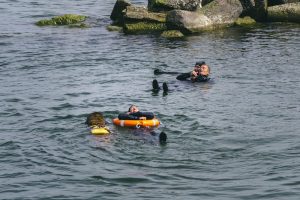
Smaller dogs may be good swimmers, but quickly get chilled. Dogs with large chests and small hindquarters are not designed for swimming.
Certain breeds tend to be strong swimmers. These include Labradors, most retrievers, the golden, the American Water Spaniel, along with the Spanish Water dog and the Irish Water Spaniel.
Chesapeake Bay retriever, English, and Irish setters, and standard poodles can also be avid swimmers.
Although the dogs mentioned above do well in the water, there are certain breeds of dogs that are consistent with the attributes needed for water rescue.
These breeds have the dispositions and the physical characteristics that are necessary for a successful water rescue dog.
These breeds have webbed toes, sturdy chests, and multi-layered coats. They are also able to withstand very cold temperatures.
Newfoundland Water dogs, Portuguese Water Dogs, and Labrador Retrievers have been used as water rescue dogs.
“Newfies” are especially apt for water rescue as their fur is waterproof, they have webbed toes, and exceptional lung capacity.
The Portuguese Water Dog has been used by fishermen not only to bring in fishing nets but has also been used to herd the fish into them.
In 1297 AD, a monk made a written record of witnessing a sailor being pulled to shore by this water dog breed.
The Importance of Proper Training for Water Rescue
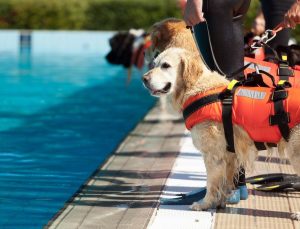
If you have the type of dog that is suited to water rescue, starting training early is of particular importance.
Another important part of training is to build muscle, stamina, and resilience, the same as is necessary with any rescue worker.
The dog also needs to be socialized. If not, they will not be able to focus on the task at hand.
They also need to be physically fit and have a good relationship with the water. An obedient, socialized dog is the best starting point for the training of any type.
It has been mentioned that, for training, it is important to have the breed of dog best suited to water rescue.
Of equal importance is the education of the dog owner. The owner is the principal for water work, and the behavior of the dog will be directly related to the owner.
The Northern Newfoundland Club states that the elementary rule of water rescue dog training is that ‘it is the owner who commands the dog.’
Obedience on the part of the dog is very important. Equally important is the dog owner’s responsibility to both command and coordinate the dog during rescues.
Today’s water rescue training has become organized and highly specialized. The K9’s have been trained to work jointly with lifeguards, to tow small boats, and to bring ropes or other equipment either to shore or to a boat.
When training, you want to take advantage of how dogs learn. Dogs, if they find something rewarding and enjoyable, will want to do it again.
So when training, remember that there has to be something in it for the dog.
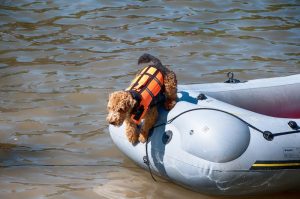
Most dogs are food motivated. Rewarding specific actions with food is usually positive for the dog. Just remember to keep the treats on the small side.
Maybe your dog is motivated by games or playing tug of war with a toy. Use this play as a reward, just as you would food items.
By repeating these actions, your dog will make the association between what he did and the reward he got for doing it.
Remember to have patience and keep training sessions to 15 – 20 minutes. End each session on a positive note, as this will encourage the dog for the next session.
Any type of punishment will defeat the purpose of training. All the dog will learn is that there is nothing good in the exercise for him.
It can also cause the dog to become fearful, and this will create a situation where the dog will be less likely to learn at all.
The three main stages of water rescue dog training are:
- The Basic Stage. In this stage, the dog gets to know the environment. The boat, the training area, the water, and tasks such as fetching.
- The Intermediate Stage. Entering the water by jumping in from shore or boat, responding to commands, stamina, and attempts to rescue.
- The Advanced Stage. Complex commands, hazardous conditions, and retrieval when an object or high waves hide a person.
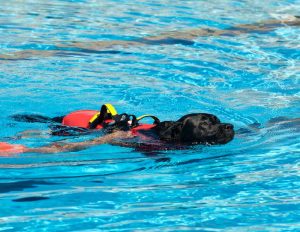
How to Start Training Your Dog For Water Rescue?
Playing in the Water
It is best to start acclimating your dog to water slowly. Use a sprinkler to get him used to the feel of water on its coat, paws, and face. A kiddie pool is ideal for starting your pooch off.
Swimming Lessons
To be on the safe side, make sure that your dog has a life vest specially made for dogs.
This will give you peace of mind and help the dog stay afloat. Lessons should take place in an enclosed pool, and if possible, with a trainer.
Do not ever force your dog into the water, but let the dog set the pace for entering the water.
Websites like www.topdoghub.com can give you advice on the best life jackets for your dog.
Jumping In
The next step, after your dog has learned to swim and is comfortable in the water, is to teach them to jump in.
You will need to be in the water and call your dog in. Once this is mastered, the next leap is into a pool, off a dock, or a small boat.
Water Retrieval
Retrieving is the next step in the process. Throw toys into the water for your dog to retrieve. Instruct him to bring them back to you. The goal is to get the dog to be as comfortable retrieving in the water as he is on land.
It is essential to know that each rescue will be different. Conditions will not always be the same, and so using different toys for the retrieving games is necessary. In this way, a dog will get used to retrieving various objects and be able to respond appropriately.
All the Pieces of The Puzzle
Your dog is comfortable in the water, loves retrieving toys, and is responding to your commands.
Have someone who is wearing a life vest, enter the water with a toy that your dog has been used to fetching from the water.
Instruct your dog to retrieve the toy. Once the dog has swum to the person, that person should hold on to the toy, but swim back alongside the dog.
Use this technique to build up the dog’s strength by slowly reducing the amount of swimming the person is doing until the dog is dragging the person through the water.
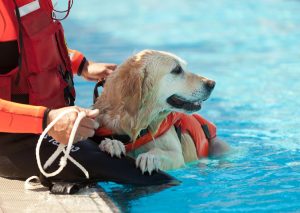
In Conclusion
Training a dog for water rescue requires about three years of work and practice.
Once prepared for water rescue, a dog’s training does not end. They will need to keep practicing their learned skills in order to keep those skills honed.
To be able to obtain certification, a water rescue dog must be ready to launch from the shore or a boat on command.
The dog then must carry some type of aid to the victim or tow the victim to safety.
The work that these dogs do is invaluable. In 2005, water rescue dogs helped with victim recovery during the aftermath of Hurricane Katrina.
In 2020, certified K9 teams assisted in the recovery operations after a Pennsylvania plane crash.
Additional information on certification and training is available from Rescue International.
